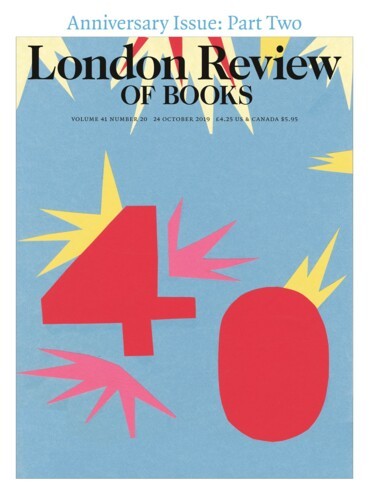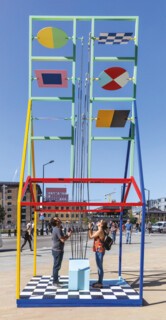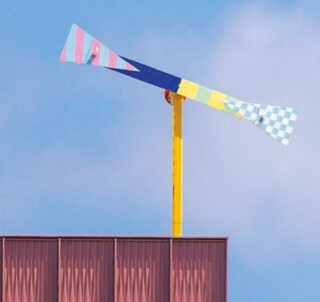Amalia Pica ’s installation Semaphores, currently on display behind King’s Cross Station, consists of three brightly coloured signalling devices, one on the ground, next to the Regent’s Canal, the other two on the rooftops of nearby buildings. Candy-striped and chequered in contrasting colours, they seem made for play and nostalgia, a kind of mechanical bunting. The device at ground level is operated by passers-by. Pulling on its cables causes differently shaped and patterned discs to flip from horizontal to vertical, composing a message. It looks like a giant toy, but it also pays homage to a more distant predecessor: George Murray’s shutter semaphore system, invented in 1795, which allowed information to be sent at great speed (London could contact Portsmouth in just seven and a half minutes). A panel next to Pica’s semaphore provides the code, so that messages can be spelled out, letter by letter, although I doubt many people bother; it’s surprisingly labour-intensive. I hope some do, however, because it’s at this point that Pica’s work departs from the cheery aesthetic that characterises the regeneration zone behind King’s Cross, with its astroturf and glossy shops. Whatever message we send won’t be returned. There are no further shutter signal posts to send it down the line or reply. The three pieces in Pica’s installation are based on two distinct historical semaphore systems, operating independently of each other. The paired rooftop works, which emulate a communication system developed in France in 1792 by Claude Chappe, a former priest, speak an entirely different language.
Chappe’s network consisted of a relay of articulated metal limbs, set on static vertical poles and manipulated by a system of pulleys to form dramatic shapes in the sky. Ninety-two of these numbered signals corresponded to a vocabulary of 8464 words and phrases. An operator at the next station viewed the signals through a telescope, reproduced them and passed them on, until they were decoded at the final station. The devices were placed on the roofs of prominent buildings across France, as well as on structures built specially for this purpose. By the early 19th century, the system was so popular that Chappe and his four brothers could place their signalling machines almost anywhere they liked – in Paris, they appeared at various times on the churches of Saint-Sulpice, Saint-Eustache and Saint-Pierre de Montmartre, as well as on the Louvre. In 1800, 61 artists signed a petition protesting against its presence there: it had led to the closure of a much loved restaurant beneath it. But it remained in place for a remarkably long time, from the immediate aftermath of the Terror in 1794 until the early 1850s, at which point more sophisticated electromagnetic transmissions took over.
It’s interesting that Pica calls her devices semaphores, because they are, in fact, telegraphs. The word tachygraphe, meaning ‘fast-writer’, came first – an attempt to lend the machines some classical gravitas. It was replaced in 1793 by télégraphe, or ‘far-writer’. Sémaphore arrived later as just another way of talking about this kind of telegraph, and both words slid swiftly into English following the French system’s unprecedented success; the adoption of ‘telegraph’ as a newspaper title came as early as 1794. It was also the obvious term to use to describe the new undersea cables, carrying the concept across to quite different (and invisible) technology. The sheer urgency of the early telegraph is hard to retrieve now that all versions of the word seem so archaic.
This is important because Pica is preoccupied by communication – its pleasures and failures – and by what falls into the gaps between words and images. Her work ranges across several media, taking in sculpture and photography, film and performance. It has involved reconstructions of Second World War sound mirrors, and incorporated flags, bells, newspapers, post-it notes, string telephones and slide projectors. In Eavesdropper (2011), performers listened for hours through a series of drinking glasses glued to a wall, picking up the sounds of the gallery and their own heartbeat. Viewers watched them, but couldn’t listen in. I am Tower of Hamlets, as I am in Tower of Hamlets, just like a lot of other people are (2011-12) is a small granite sculpture of an Echeveria succulent, whose name is a misspelling of the 18th-century Mexican botanical artist Atanasio Echeverría y Godoy. The piece isn’t kept in a gallery but lent to participants (they have to complete a lending card), who are allowed to keep it for a week. The title changes with each location, but always with a mistake of some sort (it should be ‘Tower Hamlets’). This is a matter of history and its transmission: information, Pica tells us, warps and distorts over space and over time. Old mistakes return to haunt us. Several of her works have involved modifying existing monuments, or inventing new ones; Semaphores, with its new deceptions and inherited forms, does a little of both.
At its height, the Chappe telegraph network spread for three thousand miles across France, and into Germany and Northern Italy. As modern Paris changed beyond recognition in the early 19th century, the telegraph cranked enigmatically overhead. It was used primarily for conveying state and military information (and, from 1803, the numbers of winning lottery tickets): early witnesses were baffled and alarmed by its strange appearance on familiar rooftops and the thought that it might be used to send sinister secret messages. Victor Hugo wrote that he despised the ‘big black insect’ for its ugliness and meagre preoccupation with the affairs of the world, as well as for the ‘dark terror’ induced by its inscrutable transmissions. Later, Thomas Carlyle described the telegraph’s wooden elbows ‘jerking and fugling in the air’: ‘On the whole, is it not, O Reader, one of the strangest Flame-Pictures that ever painted itself; flaming off there, on its ground of Guillotine-black?’ Yes and no, because the telegraph didn’t work in the dark, and its use was hampered by fog or cloud. Pica’s work, too, stops moving in bad weather, or when the sky turns ‘Guillotine-black’. But, unlike Chappe’s devices, Pica’s two rooftop telegraphs aren’t made to move by hidden operators. A motor in each structure animates its waving arms. What are they trying to say? One semaphore spells out ‘blabber’, the other ‘chatter’. They could be talking to each other, but they’re just talking.
Born in Argentina during the Dirty War, Pica has addressed techniques of state control in many of her works – Venn Diagrams (under the Spotlight), for example, which deploys motion sensors to activate coloured spotlights, overlapping at their edges. Venn diagrams, used to model group dynamics, were banned in schools during the military dictatorship because of their ability to articulate relations of inclusion or exclusion. This fact gives Pica’s playful telegraphs a troubling inflection. Such works test the limits of art’s ‘publicness’. Her use of outmoded forms of communication, the content of their messages lost to us, isn’t (as it could appear) a nostalgic indulgence, but points to what we don’t understand about the systems that affect us now.*
Latticed by the canal, by accretions of infrastructure past and present, King’s Cross is a networked space. DeepMind is soon to move into a grand new building there. Last month it emerged that the property developers Argent were using facial recognition software to monitor visitors to the area as part of a secret agreement with the local police. The old telegraphs were once instruments of surveillance and control, although as with any new technology, people grew used to their alien presence and no longer really saw them. Only at times of crisis, in the wake of the July Revolution, for instance, was the telegraph scrutinised again. If you approach Pica’s work from the station, six cranes and a series of concrete service shafts announce a new construction project, the KGX1 building. Most of this vast ‘landscraper’ will be occupied by Google, which in pursuit of deregulation has been funding US think tanks that deny climate change and oppose internet privacy controls. Could Pica’s jazzy semaphores also be a reference to the Google logo’s primary colours? Hiding in plain sight: less a homage than a warning.
Send Letters To:
The Editor
London Review of Books,
28 Little Russell Street
London, WC1A 2HN
letters@lrb.co.uk
Please include name, address, and a telephone number.



